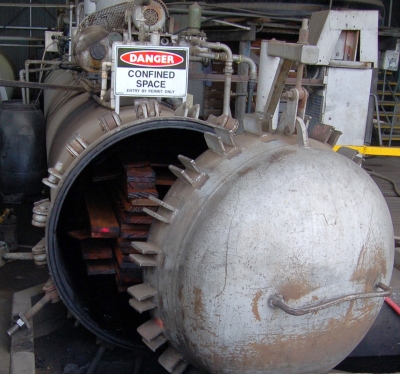Treatment methods

Treatment methods range from simple brush-on techniques through to vacuum pressure impregnation.
Each method has its advantages and disadvantages, including considerations relating to cost, infrastructure required, suitability for the product being treated, and suitability for the chemical formulation being used.
The best method for a particular product also depends on the hazard level it needs to be treated to. For example, radiata pine framing used internally and treated to H2 (such as in ‘blue pine’) can be effectively treated by spraying the timber with synthetic pyrethroids. On the other hand, timbers used in higher hazard situations require more toxic chemicals and application techniques that can achieve a much deeper level of penetration into the wood cells.
Below are the most common methods used to treat timber with preservatives.
Brush and spray
The oldest and easiest way to apply a preservative is with a brush. This method is commonly used with paints, stains, decay inhibitors and creosote. Obviously, a brushed-on treatment can only be applied to exposed surfaces, and the absorption of the solution depends on the timber characteristics. Nonetheless, it is still widely used, especially in domestic situations, and is an excellent way of applying a protective weather-resistant coating to external timber that has already been treated against insects and fungi.
Spray booths are typically used to apply synthetic pyrethroids, such as bifenthrin and permethrin. This is the most common method for treating H2F ‘blue pine’ framing material.
Immersion and dip diffusion
Immersion treatments use a bath that allow the timber to be lowered into the preservative, which is typically boron-based. The process is also called dip diffusion because the chemicals gradually diffuse through the sapwood via the water in the wood cells.
Sap replacement is a method of treating round logs by immersing the butt end in a bath and allowing the timber to stand vertically until the preservative has permeated the sapwood. It works by drawing the preservative up through the sapwood as the sap evaporates out of the top of the log.
Vacuum pressure impregnation
Vacuum pressure impregnation is the most effective way to control the depth of penetration of the preservative chemicals. In the full cell method, the timber is pre-dried and then placed in the pressure cylinder. A vacuum is drawn off and the cylinder is flooded with preservative. Pressure is then applied to push the preservative into the cell cavities. Once the pressure is released, the preservative is pumped back into the holding tank and a final vacuum is drawn to remove any excess preservative.
Vacuum pressure treatment can be used with most preservatives, and different combinations of vacuum, pressure, cycle duration and chemical concentration are used to achieve different results.
However, although this process forces the treatment chemicals into the wood cells under high pressure, it is still only able to fully penetrate the sapwood region of the piece. As we discussed in Section 2: Durability, the heartwood region of all timber species is very difficult to treat, because the cell cavities are blocked with waste products and tannins from the growing tree.
There is a process called incision, where incisions are made in the surface of the timber using a spiked roller to improve penetration, but this technique is generally only used with sleepers and other landscaping timbers.
AS/NZS 1604 sets out the minimum penetration requirements for different timber products and hazard levels. In all cases the sapwood penetration must be 100%, plus a specified envelope of protection around the heartwood region. When the treated timber is put into service, any drill holes, notches or re-cut ends that expose untreated heartwood material should be re-sealed with a brush-on preservative in order to maintain the protection, particularly from termite attack.
It’s also the case that water-borne preservatives, such as CCA, re-introduce a substantial amount of water into the wood during the treatment process. So before the timber is packaged and branded for structural use it’s re-dried back down to equilibrium moisture content. This is generally done via air drying (to fibre saturation point) and then kiln drying (to EMC).
Re-drying also helps to reduce distortion and shrinkage problems such as bow, spring, twist and checking when the timber is later exposed to normal weather conditions. However, high-value timber products should still be coated with a paint, stain or other sealant to protect the surface from the effects of sunlight and rainwater over time.
Re-drying is less important for landscaping sleepers, and it’s not necessary at all for round logs, since they’re a much more stable shape and aren’t prone to the drying stresses that tend to distort sawn timber. These products are generally sold ‘wet after treatment’.